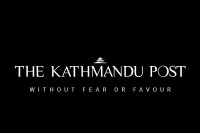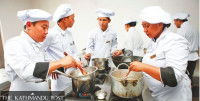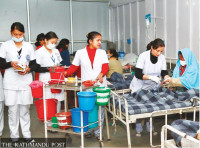Miscellaneous
NOC introduces auto pricing in fuel sector
The government on Monday adopted an auto pricing mechanism on the oil business—diesel, petrol and kerosene—for the first time, in a move to end costly fuel subsidies.
Sangam Prasain
In the new arrangement, the price of diesel and petrol will rise or fall when there is a minimum two percent fluctuation in the cost of finished products as determined by the Indian Oil Corporation (IOC), the sole supplier of gasoline products to Nepal.
“In case of an oil price shock, the Nepal Oil Corporation will control prices with the help of a fund,” said NOC Managing Director Chandika Prasad Bhatta, adding that the process has begun to set up the fund. The oil monopoly has got Rs 500 million from the government for the purpose. The NOC will spend from the fund if it suffers losses and deposit money if it makes a profit. The system, not enforced for liquefied petroleum gas (LPG), will come into effect on Tuesday. Prices are revised every two weeks based on the tariff sent by the IOC. The supplier reviews export prices of petrol and diesel every fortnight while the prices of kerosene, aviation fuel and LPG are revised every month.
Announcing the new system on Monday, the NOC slashed Rs 1.44 on a litre of petrol and 27 paisa per litre of diesel and kerosene. Petrol will now cost Rs 133.06 per litre, while a litre of diesel will cost Rs 105.23 in Kathmandu Valley.
“The measure is expected to cut the burgeoning losses of NOC and enable private sector’s entry into the business,” said Sunil Bahadur Thapa, minister for commerce and supplies.
He said the strategy would put the NOC’s finances back on track and allow domestic fuel prices to drop and rise in line with international prices over a period. On September 19, the Cabinet had given a go-ahead for the NOC to implement automatic pricing for petroleum products.
“The move is based on the recommendation of the parliamentary committee, and as suggested by high-level committees in the past,” said Thapa. The state-owned
utility has been subsidising gasoline prices, incurring huge losses, as part of the government’s effort to tame inflation. NOC’s loans from the government and banks and financial institutions stand at Rs 36.66 billion.
The monthly projected losses of the NOC dropped to Rs 2.8 million this month largely due to a fall in global crude prices. An operating profit is expected from next month if the trend continues. Known for being eternally in the red, NOC suffered losses of Rs 1.22 billion in March and the losses narrowed down to Rs 33.5 million in August.
However, with Monday’s revision, the projected losses have increased to Rs 36.2 million. It currently enjoys a profit of Rs 11.88 on a litre of petrol, Rs 13.95 on a litre on kerosene and Rs 0.8 per litre of diesel.
Similarly, its profit on a litre of aviation fuel sold to domestic and international carriers stands at Rs 39.41 and Rs 46.63, respectively. However, its losses in the LPG business alone stand at Rs 829.6 million or Rs 553 per cylinder.
Dual cylinder pricing date deferred
The government on Monday said it has deferred the deadline for introducing dual pricing for liquefied petroleum gas by a short period as some amendments were necessary to the dual LPG Supply and Distribution Orders.
The government plans to enforce colour-coded LPG cylinders in the market—red for households and blue for commercial users. It plans to subsidise red cylinders and sell blue ones at the cost price. An LPG cylinder costs Rs 1,470 in the market. The government has been subsidising Rs 553 per cylinder.
“As the amendments are almost ready, we will implement both dual pricing and dual cylinder systems soon,” said Minister Thapa.




 16.58°C Kathmandu
16.58°C Kathmandu










